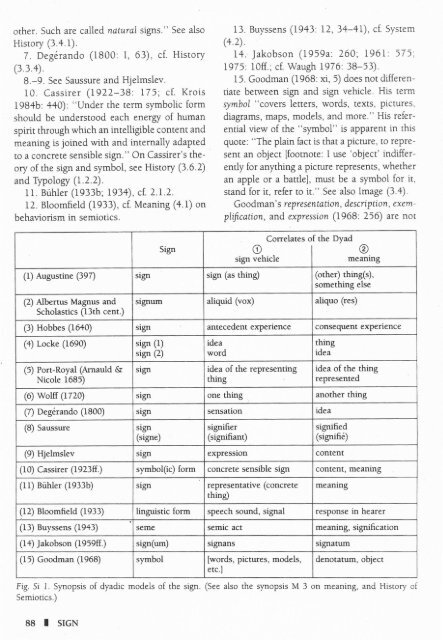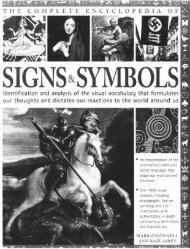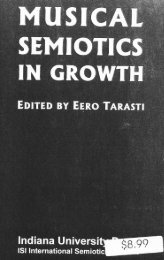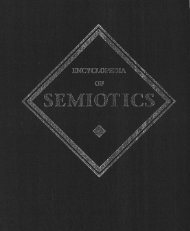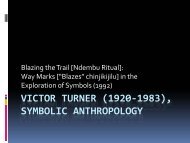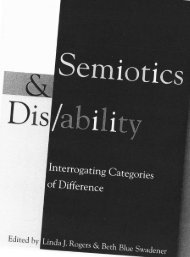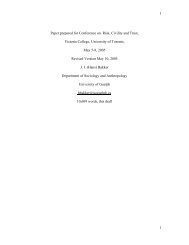Handbook of Semiotics by Winfried Noth - SemioticSigns.com
Handbook of Semiotics by Winfried Noth - SemioticSigns.com
Handbook of Semiotics by Winfried Noth - SemioticSigns.com
You also want an ePaper? Increase the reach of your titles
YUMPU automatically turns print PDFs into web optimized ePapers that Google loves.
orher. Such are called natural signs." See also<br />
History (3.1.1).<br />
7. Degrirando (1800: I, 63), cf. History<br />
(3.3.4).<br />
8.-9. See Saussure and Hjelmslev.<br />
10. Cassirer (1922-38 175; cf. Krois<br />
1984b: 440): "Under the term symbolic form<br />
should be understood each energy <strong>of</strong> human<br />
spirir through which an intelligible content and<br />
meaning is joined with and internally adapted<br />
to a concrete sensible sign." On Cassirer's theory<br />
<strong>of</strong> the sign and symbol, see History Q.6.2)<br />
and Typology (L.2.2).<br />
Il. Brihler (1933b; 1934), cf..2.1.2.<br />
12. Bloomfield (I933), cf. Meaning (4.1) on<br />
behaviorism in semiotics.<br />
I3. Buyssens (1943 lZ,34-4I), c[ System<br />
(4 2)<br />
14. Jakobson (I959a: 260; L96l: 575;<br />
1975: 10ff.; cf. Waugh L976:38-53).<br />
15. Goodman (1968: xi, 5) does not differentiare<br />
between sign and sign vehicle. His term<br />
rymbol "covers letters, words, rexts, pictures,<br />
diagrams, maps, models, and more." His referential<br />
view <strong>of</strong> the "s)'mbol" is apparent in this<br />
quote: "The plain fact is that a picture, to represent<br />
an object [footnote: I use 'object' indifferently<br />
for anything a picrure represents, whether<br />
an apple or a battle], must be a symbol for it,<br />
sund for it, refer to it." See also Image (3.4).<br />
Goodman's r epr esen tation, descrip ti o n, exem'<br />
plifcation, and expression (1968: 256) are not<br />
Sig.<br />
Correlates o<br />
srsnPehicle I<br />
the Dyad<br />
@<br />
meaning<br />
(I) Augustine (397) srgn sign (as thing) (other) thing(s),<br />
something else<br />
(2) Albenus Magnus and<br />
Scholastics (l3th cent.)<br />
srgnum aliquid (vox) aliquo (res)<br />
(3) Hobbes (r6a0) srgn antecedent experience consequent experience<br />
(a) Locke (1690)<br />
(5) Port-Royal (Arnauld &<br />
Nicole 1685)<br />
srCn (1)<br />
sign (2)<br />
sign<br />
idea<br />
word<br />
idea <strong>of</strong> the representing<br />
thing<br />
thing<br />
idea<br />
idea <strong>of</strong> the thing<br />
represented<br />
(6) woH (1720) srgn one thing another thing<br />
(7) Degerando (1800) slgn sensatron idea<br />
(8) Saussure sign<br />
(signe)<br />
signifier<br />
(signifiant)<br />
signified<br />
(sigrifie)<br />
(9) Hjelmslev srglr exPressron content<br />
(10) Cassirer (I923tr.) symbol(ic) form concrete sensible sign content, meaning<br />
(lr) Biihler (I933b) slgn rePresentative (concrete<br />
thing)<br />
meanrng<br />
(I2) Bloomfield (1933) linguistic form speech sound, signal response in hearer<br />
(13) Buyssens (1943) seme semrc act meaning, signification<br />
(14) Jakobson (1959tr.) sign(um) signans signatum<br />
(r5) Goodman (1968) symbol [words, pictures, models,<br />
etc.l<br />
denotatum, object<br />
Fig. 5i I. Synopsis <strong>of</strong> dyadic models <strong>of</strong> the sign. (See also the synopsis M 3 on meaning, and History o[<br />
<strong>Semiotics</strong>.)<br />
88 I SIGN


